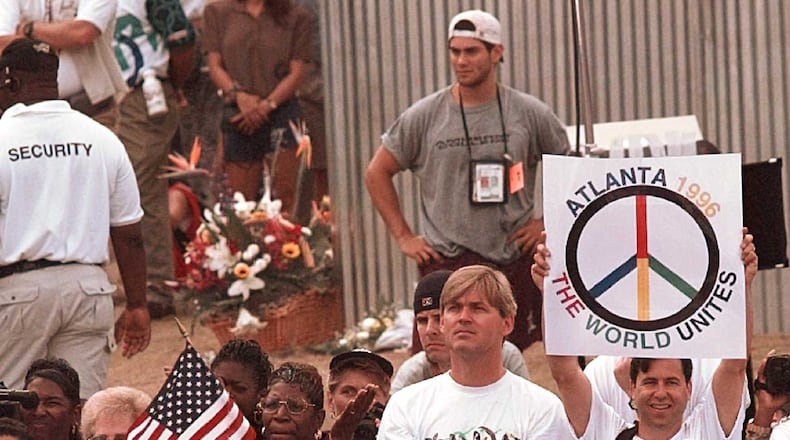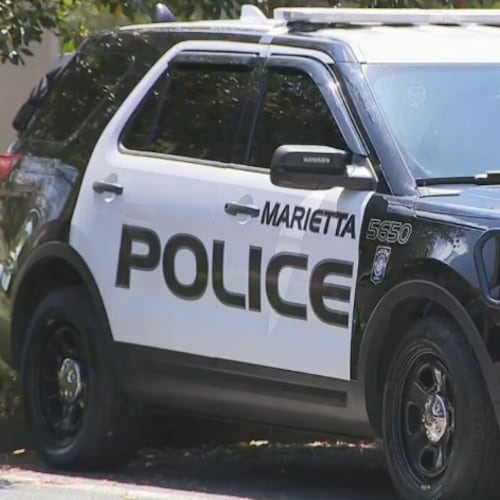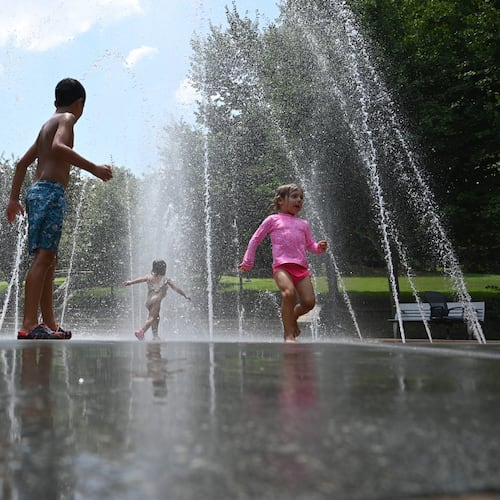This article was published July 31, 1996. Reporting by Lucy Soto, Maureen Downey, Dale Fuchs, Michelle Hiskey, Carl Hoover, Chick Ludwig, Becky Thatcher, Laura Wisniewski as Centennial Olympic Park, a central gathering spot during the 1996 Olympics in Atlanta, reopened on July 30, three days after a bomb exploded there near a concert stage.
They came by the tens of thousands - to pray, to show that a pipe bomb couldn’t shatter their spirit, to experience one of the most moving moments of the 1996 Olympics.
Tuesday’s re-opening of Centennial Olympic Park - three days after a pipe bomb shattered its festive innocence and killed one woman - was filled with tears, defiance, joy and spiritual comfort.
“This has been, in every sense of the word, the people’s park. You didn’t need a ticket to come here,” ACOG co-chairman and former Mayor Andrew Young told an elbow-to-elbow crowd. “The whole world was welcome here. We want everyone to know there’s no need to feel alienated from this loving community. There’s nothing keeping you out.”
Seventeen days earlier, cameras from around the world recorded a massive ceremony initially opening Centennial Olympic Park, heralded as Atlanta’s new town square. But that was more for the speechmakers, the politicians, the dignitaries.
Tuesday’s reopening was in many ways its real birth. It was a celebration of people.
“We are determined we will not be defeated,” said Anthony Dixon, 42, of Rex, a special agent with the Federal Highway Administration. He and wife Delores, 41, brought their three children, Anthony, 9; Andre, 7; and Anna, 3.
“We’ve been down here six times,” Dixon said. “This is our Olympics. We don’t have any tickets to the venues.”
Credit: DAVID CRUZ
Credit: DAVID CRUZ
Before the blast, the park became a place to party, to frolic in the high-tech Fountain of Rings, to stroll under a 100-year-old pecan tree, to listen to every flavor of music, to trade Olympic pins and to watch and talk to people. All for free.
On Tuesday, Atlanta Olympic chief Billy Payne called it also a place for “remembrance and revival.”
In the morning, the park teemed with people who attended a service for the bombing victims. Alice Stubbs Hawthorne of Albany died of shrapnel injuries, and more than 100 others were injured. Melih Uzunyol, a Turkish journalist, died of a heart attack just after the blast.
Many in the crowd held hands, cried and interrupted Young with applause. Volunteers distributed memorial green and gold ribbons. And although the dais was filled with other dignitaries - Gov. Zell Miller, International Olympic Committee President Juan Antonio Samaranch, Mayor Bill Campbell and swimmer Janet Evans - they held their tongues.
The victims had a moment of silence.
Then, with water bursting from the Fountain of Rings and a gospel choir belting out “Hallelujah!,” Payne declared the park open again.
“This was the perfect testimony for Atlanta at a time when the city desires to welcome all the world,” said Paula L. Dressel, of Virginia- Highland, who cried during the ceremony.
Credit: Mike Luckovich
Credit: Mike Luckovich
Thousands of people began converging on the park entrances an hour before it opened at 8 a.m. Once inside, roughly 1,000 journalists from around the world raced to record their thoughts and feelings. Celebrities, athletes and politicians had their own roaming mobs of spectators and journalists.
After the service ended, lines quickly formed at the commercial attractions created by Olympic sponsors.
Roughly 1,500 shoppers waited for the doors to reopen at the Superstore, according to store manager Carla Griffin. By noon, the line was longer than it was in the week before the bombing, with sweating shoppers backed up almost to Techwood Drive. They swamped the aisles, hoarding brand-name souvenirs.
“I’m so excited to be here,” said Pennsylvania tourist Jane Staver, hauling $200 worth of hats, stuffed animals and T-shirts. “I’m not going to let some madman ruin the trip I’ve planned for years.”
The South African vocal group Ladysmith Black Mambazo didn’t overlook the significance of being the first entertainers to take the AT&T Global Olympic Village stage since the bombing.
Founder and lead singer Joseph Shambalala, 55, rearranged the a cappella ensemble’s set list. Rather than Ladysmith’s traditional opening, the group began with a prayer, “King of Kings,” that segued into a call for peace and brotherhood.
“‘Will you kill if they ask you to? Don’t do it,’” Shambalala recited the lyrics.
In the backdrop, as a light breeze flapped flags at half-staff, military personnel wearing fatigues marched the sidewalks, security officials inspected bags and packages. Plainclothes police patrolled the park’s perimeter with German shepherds and other large dogs, and electronic sentries, shaped like small cable cars, loomed over the entrances.
Credit: AP
Credit: AP
Hundreds of young people from religious groups prayed, sang and carried flowers.
“We’re not afraid at all,” said Delia Cartier of Portsmouth, Va., a member of the Liberty New Testament Church. “I believe that God’s protection can be put over the city.”
Sarah C. Wood, an officer with the Olympic security team, brought a basket of flowers to place near the bombing site at the AT&T Global Olympic Village tower. Visitors swarmed the area almost immediately after the park gates opened. It was littered with flags and flowers. The “Today” show’s Katie Couric and Bryant Gumbel broadcast their morning show from the area.
“The flowers,” Wood said, “represent the compassion we feel for what has happened, the comfort we hope to give to the family and the strength to go on.”
Some victims of the blast returned for their first visit since the horrific blast.
Leslie Heinz of Lexington, Ky., was there, just out of the hospital and still looking battered. Shrapnel tore into her back and is permanently lodged in her chest.
“I have a permanent Olympic medal,” she joked, then became serious. “I wanted to pay respects to the family who lost their loved one. . . . I’m not going to let this stop me. I’m going to keep going to the Olympic Games. "
That became a refrain for many who visited the park on its day of revival.
“I wanted to be a part of what the city is feeling,” said Greg Trefry, 42, of Marietta. “These are our Games, and this is our city, and in my heart I felt like I had to be here.”
Keep Reading
The Latest
Featured







